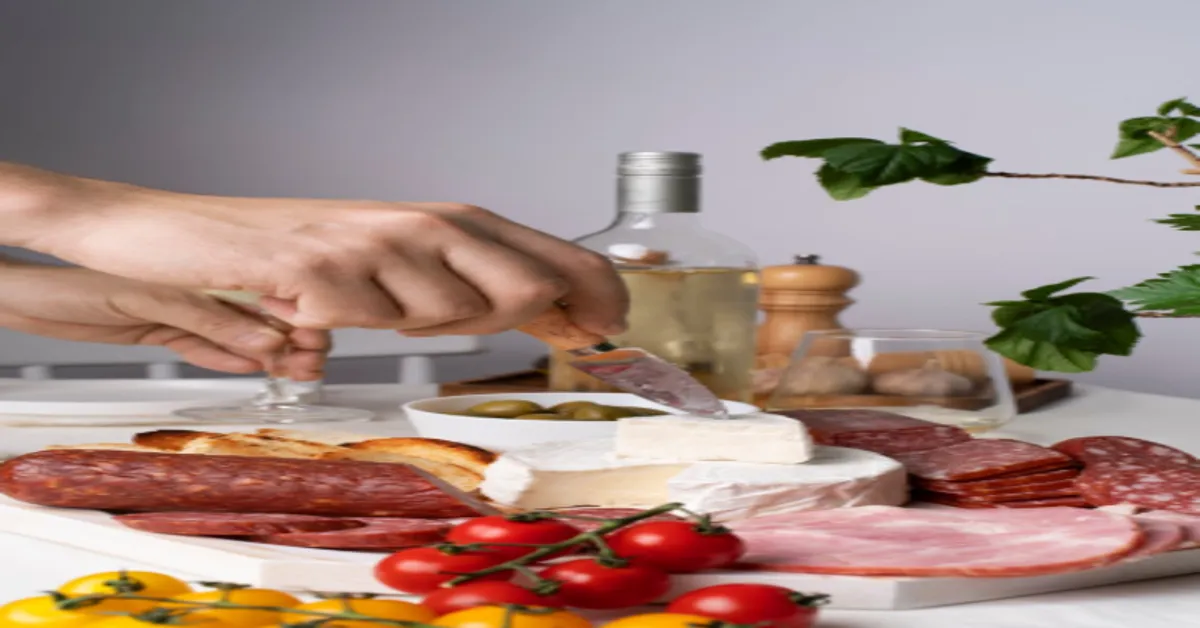In a global food economy increasingly dominated by mass production, preservatives, and convenience, soppressata holds its ground not just as a culinary item, but as a cultural expression. For centuries, soppressata’s has been a symbol of family labor, rural ingenuity, and seasonal patience—a type of salume (Italian cured meat) made from coarsely ground pork, traditionally seasoned, encased, and air-dried in cellars or barns over winter. Today, it is seeing a resurgence. Not as a hipster novelty or deli trend, but as a response to the deeper appetite for authenticity, craftsmanship, and time-honored taste.
This article explores soppressata in its full dimensions—its history, regional distinctions, production methods, nutritional content, cultural rituals, modern adaptations, and global significance in 2025. Whether you’re a chef, a home cook, or just a curious eater, understanding soppressata’s is about more than meat. It’s about time, place, and people.
What Is Soppressata?
Soppressata is a type of dry-cured Italian salami, known for its flattened shape, rich seasoning, and dense, chewy texture. Unlike many sausages, soppressata is often made with hand-cut chunks of pork, which are then mixed with salt, black pepper, chili flakes, garlic, and sometimes wine or fennel, depending on the region. The meat is then packed into a natural casing (usually pork intestine), pressed, and hung to dry for weeks or months.
The word “soppressata’s” comes from the Italian verb sopprimere, meaning “to suppress” or “press down.” It refers to the traditional method of pressing the salami under weight to achieve its signature flattened profile.
Key Characteristics of Traditional Soppressata
| Feature | Description |
|---|---|
| Origin | Southern Italy, especially Calabria, Basilicata, and Apulia |
| Base Ingredient | Pork (shoulder, loin, or thigh) |
| Curing Method | Dry-cured and air-dried without artificial preservatives |
| Texture | Coarse, dense, slightly oily |
| Flavor Profile | Savory, spicy, sometimes slightly sour or smoky |
| Shelf Life | 6 to 12 months, depending on conditions |
Unlike other salumi like finocchiona or coppa, soppressata’s is prized for its bold character and rural authenticity, often made in small batches using family recipes passed down over generations.
The Historical Roots of Soppressata
Soppressata’s origins can be traced back to rural Southern Italy during the Middle Ages, where meat preservation was essential for survival in winter. Every part of the pig was used. The best cuts were reserved for fresh meals, while tougher cuts and trimmings were ground, spiced, and cured.
Soppressata’s became central to la maialata—the communal pig slaughter that took place every December or January. Families would gather to butcher pigs, share knowledge, and make their annual supply of sausages and cured meats.
| Century | Development |
|---|---|
| 11th–15th | Use of salt and wine as early preservation tools |
| 16th–18th | Regional varieties emerge in Calabria and Apulia |
| 19th Century | Introduction of pressing boards and fermentation rituals |
| 20th Century | Industrial versions begin, but artisan production persists |
| 21st Century | Revival of traditional techniques and DOP certification |
Today, Calabrian soppressata’s holds Protected Designation of Origin (DOP) status in Italy, recognizing its cultural and historical importance.
Types of Soppressata by Region
| Region | Characteristics |
|---|---|
| Calabria | Spicy, red chili flakes, sometimes smoked, known for its fiery and robust flavor |
| Basilicata | Mild, rich in black pepper and garlic, with dense meat texture |
| Apulia | Pressed very flat, uses fennel seeds and wine, with a subtle herbal note |
| Molise | Often made with a mixture of pork and beef, and aged longer |
| Abruzzo | Slightly acidic from the use of local wine must, aged in high-altitude cellars |
Each variety reflects not only local tastes but also climatic conditions, access to spices, and storage environments.
How Soppressata Is Made: Step-by-Step
The traditional process of making soppressata’s is both simple and sacred, involving meticulous preparation and community participation.
1. Meat Selection
High-quality cuts of pork are chosen—typically shoulder, loin, or ham trimmings. Fat is important for texture but must be clean and well-balanced.
2. Cutting and Seasoning
Meat is hand-chopped or coarsely ground, then mixed with salt, spices, garlic, and sometimes wine. Spices vary by region and family.
3. Stuffing and Tying
The seasoned meat is packed tightly into natural casings, often tied by hand in 6–10 inch lengths. Air pockets are removed carefully.
4. Pressing
Salamis are laid flat and pressed under wooden boards or stone slabs for several days, giving soppressata’s its trademark flattened look.
5. Fermentation and Drying
The soppressata is hung in a controlled environment (cool and dry, but not too dry) for 4 to 10 weeks, depending on desired firmness.
6. Aging
Optional aging in underground cellars or ventilated barns can continue for up to six months for a more intense flavor.
Nutritional Profile
Soppressata’s is high in protein and fat, with moderate sodium and spice content. It’s best consumed in moderation, often as part of antipasto or a charcuterie spread.
| Nutrient (per 50g) | Approximate Value |
|---|---|
| Calories | 210 |
| Protein | 11g |
| Fat | 17g (of which 6g saturated) |
| Sodium | 680mg |
| Carbohydrates | 0g |
| Fiber | 0g |
Though calorie-dense, soppressata provides flavor intensity in small portions, which is why it’s traditionally eaten with bread, olives, or cheese.
Soppressata in Cultural Context
In Southern Italian culture, soppressata’s is more than food. It’s a rite of passage, a family ritual, and a symbol of self-reliance.
- In Calabria, young men were once judged by their ability to season soppressata correctly. It was part of marriage considerations.
- In Basilicata, soppressata was stored in terracotta jars of lard to preserve it for months.
- In Apulia, the salumi cellar was a source of pride, with annual tasting ceremonies around Easter or Saint Joseph’s Day.
These traditions continue in diaspora communities, where making soppressata at home is seen as a link to ancestral identity.
Soppressata in Modern Cuisine
Today, chefs across the globe are reinterpreting soppressata in new culinary contexts.
| Dish | Description |
|---|---|
| Soppressata Pizza | Crumbled soppressata adds smoky heat to Neapolitan or New York–style pies |
| Charcuterie Boards | Paired with pickled vegetables, fig jam, and hard cheeses |
| Pasta Arrabbiata | Sautéed soppressata boosts the sauce’s depth and spiciness |
| Soppressata & Honey Crostini | The salty meat contrasts perfectly with soft cheese and sweet honey |
| Soppressata Chips | Thin slices baked crisp as a protein-rich snack |
This versatility has made soppressata a darling of the nose-to-tail and artisan food movements, especially in the U.S., Canada, and northern Europe.
Making Soppressata at Home: What to Know
Though intimidating, home-curing soppressata’s is feasible with the right tools:
- A meat grinder or sharp knives
- Natural hog casings
- Non-iodized salt and high-quality spices
- Cheesecloth, string, and fermentation weights
- A cool, dark space for drying (50–60°F, ~70% humidity)
DIY soppressata makers must follow hygiene and food safety protocols, particularly around botulism prevention (using curing salts like Prague Powder #2 if needed). It’s both an art and a science—but rewarding.
Soppressata and Sustainability
One reason for soppressata’s revival is its sustainable profile. It uses:
- Every part of the animal
- Minimal additives or chemicals
- Low energy for preservation
- Long shelf life, reducing food waste
Small-batch producers often work with heritage breeds and local feed systems, contributing to rural economies and biodiversity.
The Future of Soppressata
| Trend | Description |
|---|---|
| Artisan Butchery Resurgence | Young butchers are reviving traditional salumi with innovative twists |
| DIY Food Movements | Home curing and fermentation kits are growing in popularity |
| Regional Label Protection | Italian and EU laws pushing for tighter origin and ingredient protections |
| Plant-Based Imitations | Some chefs are experimenting with lentil- or mushroom-based soppressata analogs |
| Global Flavor Fusions | Soppressata with miso, Sichuan pepper, or smoked paprika hitting gourmet shelves |
As global consumers seek authentic, slow-made foods with traceable stories, soppressata may continue to rise—not in volume, but in value.
Final Thoughts: Why Soppressata Still Matters
To know soppressata is to understand a slower, more deliberate relationship with food. It is not a snack or a trend—it is a process, a memory, a marker of season and soil. In its densely packed form, soppressata holds stories: of migration, survival, family feasts, and the hands that tied it off and hung it to age.
As we continue to build a food system that honors both taste and sustainability, soppressata reminds us that the oldest methods are often the wisest—and that preservation is not just about meat, but about culture.
Let it hang. Let it dry. Let it teach us again how to wait, taste, and remember.
Frequently Asked Questions (FAQs)
1. Is soppressata the same as salami?
Not exactly. All soppressata is a type of salami, but not all salami is soppressata. Soppressata is distinguished by its flattened shape, coarse meat cut, and regional seasoning.
2. Can soppressata be eaten raw?
Yes—because it’s dry-cured and aged, it’s safe to eat straight from the package. It’s never cooked, only preserved.
3. How should I store soppressata?
Once opened, wrap it in parchment or wax paper and keep it in the fridge. It can last 2–3 weeks refrigerated, or longer if vacuum sealed.
4. Is soppressata spicy?
Some types are. Calabrian soppressata is known for its heat. Others, like those from Basilicata, are peppery but mild.
5. Can I use soppressata in cooking?
Absolutely. It crisps beautifully, melts fat into sauces, and adds umami to eggs, pasta, and stews.











